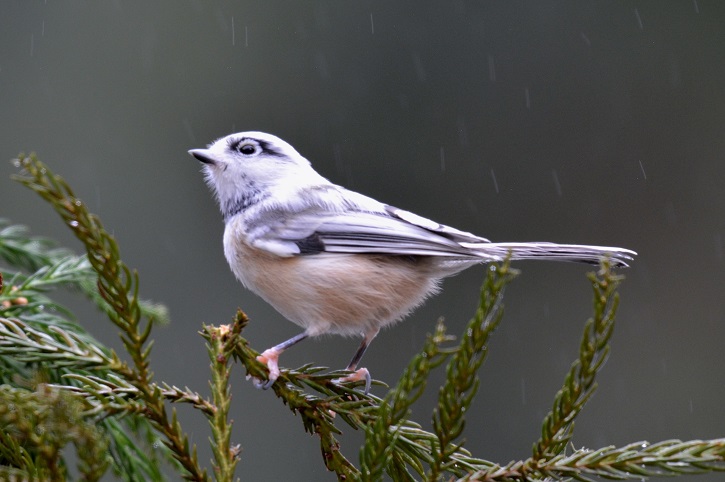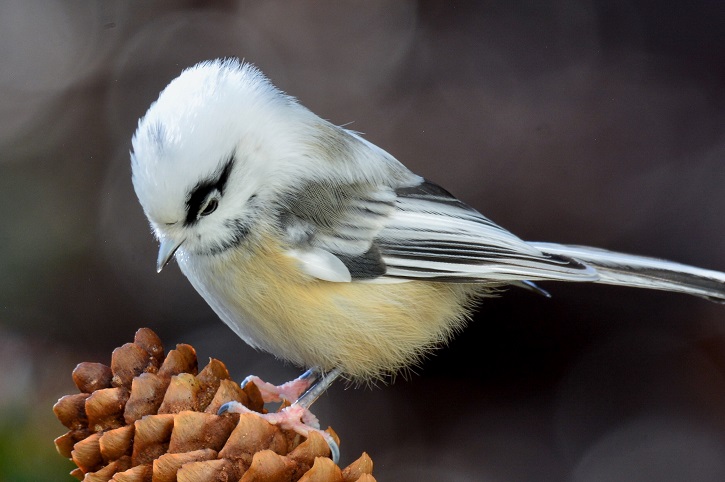In case our readers are tired of the endless news stories about the yellow Northern Cardinal in Alabama, a surprising color variant of a Black-capped Chickadee has shown up recently in our home state of Massachusetts.
A private homeowner in Charlton sent us some pictures of the bird, which was coming to her feeders.

©Laurie Dearnley

A partially leucistic Black-capped Chickadee in Charlton. ©Laurie Dearnley
In some ways, this bird looks more like a tit from the Eurasian genus Cyanistes—a group very closely related to North America’s chickadees.
However, Wayne Petersen and David Sibley confirmed that this bird’s body shape and plumage is indeed consistent with a partially leucistic Black-capped Chickadee.
What is Leucism?
Leucism is a genetic condition that prevents a bird’s body from depositing pigments in feathers, leaving some parts of the bird white or paler than normal. Leucism is not to be confused with albinism. Albino birds only lack a single pigment (melanin) responsible for producing blacks and browns, but the issue is not getting the pigment where it needs to be—albino birds simply do not produce melanin at all. While these birds end up with no black or brown anywhere (even in the eye!) they might retain other colors like reds and yellows. In leucistic birds, any or all colors could appear paler than normal, but their eyes (and often their skin) will be dark.
This bird is particularly fascinating because while it has retained some pigment in its feathers and its legs are partially dark, its toes are pink and unpigmented. Normally, a bird with partially pigmented feathers will have full pigmentation on its bare parts. Transporting pigment to living tissue (skin) is biologically easier than to dead tissue (feathers). It’s quite rare for a bird with partial leucism to have bare parts that are pale, and even rarer for a bird’s bare parts to be half dark and half pale.
Bird Pigments: Form Meets Function
Pigments often serve vital functions for birds beyond what we might expect. Feathers with melanin, for example, are stronger and more resistant to wear and tear than unpigmented feathers. This may be why some birds, like many gulls, have black outer edges on their otherwise-white wings. Female birds may also read certain plumage traits to indicate the physical health of potential mates. Several studies have correlated bright pigmentation with healthy immune systems in species from Zebra Finches to Red-winged Blackbirds (although never any chickadee species), and many birds with aberrant plumage show decreased mating success. Finally, birds with abnormally pale feathers tend to stick out visually, and run a greater risk of predation.
But even if this particular Black-capped Chickadee has a difficult (or short) life ahead of it, we think it’s beautiful just the way it is.


Just spotted what I think is a white capped Chickadee in the backyard. It took me by surprise how truly white its head was. We’ve always had lots of backyard songbirds, and before it flew off, my spouse was able to get a photo through the window of this little bird. Hope it becomes a regular visitor.
We had one but now we have at least half a dozen, except our have a black crown on top. The seem to arrive in groups now. We’re in Uxbridge, Mass.
I live in Strafford New Hampshire. We have a chickadee with the same markings. We named him Powder! He has been here for a few months.
We have a pair of leucistic chickadees at our feeders this year. They are acting as if they’re bonded, so I’m anxious to see if we get lots of little white fluffballs next year.
I have a very blurry picture of a what appears to be a white capped chickadee that I saw today 12-20-20, s was hike walking in Forest Park in Springfield MA.
Just had one at our feeder in Walton, NY (Catskills)
Just saw one just like it on our feeder in Toronto. Had me very confused until I saw this post.
White chickadee has been here in Auburn, WA for around 2 months.
Used binoculars for close up look.
Waiting to get a good photo.
Praying my cat doesn’t get to it before I do.
We also have two Broad-tailed Hummingbirds that still come to the feeder. I can put my head right next to the feeder and feel the vibrations of their wings. We’ve had them bring their babies to the feeders in the years past.
Keep you cat in the house, shame on you! If you are a bird lover you should know better.
Just discovered the unusual white capped chickadee on my feeder in Nashville, TN. It has been here for two days now.
White capped chickadee seen at my feeder in portland oregon on sept14.
Fran storrs
White capped chickadee seen at my feeder here in southwest Portland OR yesterday and today…September 21 and 22, 2019. I was able to snap a picture, not a very good one though.
A few of our birds had a hard time with the recent storms. We found one dead goldfinch and a dead grackle. A flock of grackles, blackbirds and red winged blackbirds arrived before the third nor’easter. They are very aggressive birds.
We also found an injured goldfinch after the second nor’easter. We put it in a box and kept it in the cellar. It survived the night and the next day we took it to a bird rehabilitator. The woman said she thought it had an impact injury.
We are hoping for a happy ending but are prepared for the worst.
We caught an unusual number of freaky-deaky leucistic chickadees at Wellfleet this year! We had one who was initially captured with normal plumage, then recaptured with a lot of white plumage, hinting at environmental factors. Fascinating!
https://www.instagram.com/p/Ba-KZHWD1pv/?taken-by=monomoybirds